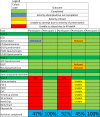Defining the prevalence and symptom burden of those with self-reported severe chronic fatigue syndrome/myalgic encephalomyelitis (CFS/ME): a two-phase community pilot study in the North East of England
- PMID: 30232103
- PMCID: PMC6150143
- DOI: 10.1136/bmjopen-2017-020775
Defining the prevalence and symptom burden of those with self-reported severe chronic fatigue syndrome/myalgic encephalomyelitis (CFS/ME): a two-phase community pilot study in the North East of England
Abstract
Objectives: To define the prevalence of severe chronic fatigue syndrome/myalgic encephalomyelitis (CFS/ME) and its clinical characteristics in a geographically defined area of Northern England. To understand the feasibility of a community-based research study in the severely affected CFS/ME group.
Design: A two-phase clinical cohort study to pilot a series of investigations in participants own homes.
Setting: Participants were community living from the area defined by the Northern clinical network of the UK.
Participants: Adults with either a medical or a self-reported diagnosis of CFS/ME. Phase 1 involved the creation of a database. Phase 2: five participants were selected from database, dependent on their proximity to Newcastle.
Interventions: The De Paul fatigue questionnaire itemised symptoms of CFS/ME, the Barthel Functional Outcome Measure and demographic questions were collected via postal return. For phase 2, five participants were subsequently invited to participate in the pilot study.
Results: 483 questionnaire packs were requested, 63 were returned in various stages of completion. 56 De Paul fatigue questionnaires were returned: all but 12 met one of the CFS/ME criteria, but 12 or 22% of individuals did not fulfil the Fukuda nor the Clinical Canadian Criteria CFS/ME diagnostic criteria but 6 of them indicated that their fatigue was related to other causes and they barely had any symptoms. The five pilot participants completed 60% of the planned visits.
Conclusions: Severely affected CFS/ME individuals are keen to participate in research, however, their symptom burden is great and quality of life is poor. These factors must be considered when planning research and methods of engaging with such a cohort.
Keywords: bedbound; chronic fatigue syndrome; house bound; severe; very severe; wheelchair bound.
© Author(s) (or their employer(s)) 2018. Re-use permitted under CC BY-NC. No commercial re-use. See rights and permissions. Published by BMJ.
Conflict of interest statement
Competing interests: None declared.
Figures


References
-
- NICE. Chronic Fatigue Syndrome/ Myalgic Encephalomyelitis diagnosis and Management in Adults and Children. 2007. http://www.nice.org.uk/guidance/cg53.
-
- Baker R, Shaw EJ. Diagnosis and management of chronic fatigue syndrome or myalgic encephalomyelitis (or encephalopathy): summary of NICE guidance. BMJ 2007;335:446–8. 10.1136/bmj.39302.509005.AE - DOI - PMC - PubMed
-
- Carruthers BM. Myalgic encephalomyelitis/chronic fatigue syndrome: clinical working case definition, diagnostic and treatment protocols. Journal of chronic fatigue syndrome 2003;11:7–115.
Publication types
MeSH terms
LinkOut - more resources
Full Text Sources
Other Literature Sources
Medical
Miscellaneous
